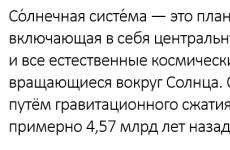How to choose a starting capacitor. Three-phase motors in a single-phase network: connection diagrams and selection of capacitors
Many owners quite often find themselves in a situation where they need to connect a device such as a three-phase asynchronous motor to various equipment in a garage or country house, which can be an emery machine or drilling machine. This poses a problem, since the source is designed for single-phase voltage. What to do here? In fact, this problem is quite easy to solve by connecting the unit according to the circuits used for capacitors. To realize this idea, you will need a working and starting device, often referred to as a phase shifter.
Selection of capacity
To ensure proper operation of the electric motor, certain parameters must be calculated.
For run capacitor
To select the effective capacity of the device, it is necessary to perform calculations using the formula:
- I1 is the nominal value of the stator current, for measuring which special clamps are used;
- Umains – single-phase network voltage, (V).
After performing the calculations, you will get the capacitance of the working capacitor in microfarads.
It may be difficult for some to calculate this parameter using the above formula. However, in this case, you can use another scheme for calculating capacity, where you do not need to carry out such complex operations. This method allows you to quite simply determine the required parameter based only on the power of the asynchronous motor.
Here it is enough to remember that 100 watts of power of a three-phase unit should correspond to about 7 µF of the working capacitor capacity.
When making calculations, you need to monitor the current that flows to the stator phase winding in the selected mode. It is considered unacceptable if the current has higher value than the nominal value.
For starting capacitor
There are situations when the electric motor has to be turned on under conditions of heavy load on the shaft. Then one running capacitor will not be enough, so you will have to add a starting capacitor to it. The peculiarity of its operation is that it will only work during the startup period of the device for no more than 3 seconds, for which the SA key is used. When the rotor reaches the rated speed level, the device turns off.
If, through an oversight, the owner left the starting devices turned on, this will lead to the formation of a significant imbalance in the currents in the phases. In such situations, there is a high probability of engine overheating. When determining the capacitance, it should be assumed that the value of this parameter should be 2.5-3 times greater than the capacitance of the working capacitor. By acting in this way, it is possible to ensure that the starting torque of the engine reaches the nominal value, as a result of which no complications arise during its startup.
To create the required capacitance, capacitors can be connected in parallel or series circuits. It should be borne in mind that the operation of three-phase units with a power of no more than 1 kW is permitted if they are connected to a single-phase network with a working device. Moreover, here you can do without a starting capacitor.
Type
After calculations, you need to determine what type of capacitor can be used for the selected circuit
The best option is to use the same type for both capacitors. Typically, the operation of a three-phase motor is ensured by paper starting capacitors, enclosed in a sealed steel casing such as MPGO, MBGP, KBP or MBGO.
Most of these devices are made in the form of a rectangle. If you look at the case, their characteristics are given there:
- Capacitance (uF);
- Operating voltage (V).
Application of electrolytic devices
When using paper starting capacitors, you need to remember the following negative point: they are quite large in size, while providing a small capacitance. For this reason, for efficient operation of a small-power three-phase motor, it is necessary to use a fairly large number of capacitors. If desired, paper ones can be replaced with electrolytic ones. In this case, they must be connected in a slightly different way, where additional elements must be present, represented by diodes and resistors.
However, experts do not recommend using electrolytic starting capacitors. This is due to the presence of a serious drawback in them, which manifests itself in the following: if the diode does not cope with its task, alternating current will begin to be supplied to the device, and this is fraught with its heating and subsequent explosion.
Another reason is that today you can find improved metallized polypropylene launch models on the market. alternating current type SVV.
Most often, they are designed to operate with a voltage of 400-450 V. They should be given preference, given that they have repeatedly shown themselves to be good.
Voltage
 Considering Various types starting rectifiers of a three-phase motor connected to a single-phase network, such a parameter as operating voltage should also be taken into account.
Considering Various types starting rectifiers of a three-phase motor connected to a single-phase network, such a parameter as operating voltage should also be taken into account.
It would be a mistake to use a rectifier whose voltage is an order of magnitude higher than required. In addition to the high costs of purchasing it, you will have to allocate more space for it due to its large dimensions.
At the same time, you should not consider models in which the voltage has a lower value than the network voltage. Devices with such characteristics will not be able to effectively perform their functions and will soon fail.
To avoid making mistakes when choosing the operating voltage, you should adhere to the following calculation scheme: the final parameter must correspond to the product of the actual network voltage and a coefficient of 1.15, and the calculated value must be at least 300 V.
If paper rectifiers are selected for operation in an alternating voltage network, then their operating voltage must be divided by 1.5-2. Therefore, the operating voltage for a paper capacitor, for which the manufacturer specified a voltage of 180 V, under operating conditions in an AC network will be 90-120 V.
In order to understand how the idea of connecting a three-phase electric motor to a single-phase network is implemented in practice, let’s perform an experiment using an AOL 22-4 unit with a power of 400 (W). the main task, which must be resolved - starting the engine from a single-phase network with a voltage of 220 V.
The electric motor used has the following characteristics:

Keeping in mind that the electric motor used has little power, when connecting it to a single-phase network, you can only buy a working capacitor.
Calculation of the capacity of the working rectifier:
Using the above formulas, we take the average value of the capacitance of the working rectifier to be 25 μF. Here a slightly larger capacitance was chosen, equal to 10 μF. So we will try to find out how such a change affects the launch of the device.
Now we need to buy rectifiers, the latter will be MBGO type capacitors. Next, based on the prepared rectifiers, the required capacity is assembled.
During operation, it should be remembered that each such rectifier has a capacity of 10 μF.
If you take two capacitors and connect them to each other along parallel circuit, then the final capacitance will be 20 µF. In this case, the operating voltage will be equal to 160V. To achieve the required level of 320 V, you need to take these two rectifiers and connect them to another pair of capacitors connected in parallel, but using serial circuit. As a result, the total capacitance will be 10 μF. When the battery of working capacitors is ready, connect it to the engine. Then all that remains is to run it in a single-phase network.
During the experiment with connecting the motor to a single-phase network, the work required less time and effort. When using a similar unit with a selected rectifier battery, it should be noted that its useful power will be at a level of up to 70-80% of the rated power, while the rotor speed will correspond to the nominal value.
Important: if the motor used is designed for a 380/220 V network, then when connecting to the network you should use a “triangle” circuit.
Pay attention to the contents of the tag: it happens that there is an image of a star with a voltage of 380 V. In this case, correct operation of the motor in the network can be ensured by fulfilling the following conditions. First you will have to “gut” the common star, and then connect 6 ends to the terminal block. Search common point should be in the front of the engine.
Video: connecting a single-phase motor to a single-phase network
The decision to use a starting capacitor should be made based on specific conditions; most often, a working capacitor is sufficient. However, if the engine being used is subjected to increased load, it is recommended to stop operation. In this case, it is necessary to correctly determine the required capacity of the device to ensure efficient operation of the unit.
Starting and running capacitors are used to start and operate electric motors operating in a single-phase 220 V network.
That's why they are also called phase shifters.
Installation location - between the power line and the starting winding of the electric motor.
Symbol for capacitors in diagrams

The graphic designation on the diagram is shown in the figure, the letter designation is C and the serial number according to the diagram.
Basic parameters of capacitors
Capacitor capacity- characterizes the energy that a capacitor is capable of accumulating, as well as the current that it is capable of passing through itself. Measured in Farads with a multiplying prefix (nano, micro, etc.).
The most commonly used values for run and start capacitors range from 1 μF to 100 μF.
Nominal voltage of the capacitor - voltage at which the capacitor is able to operate reliably and for a long time, maintaining its parameters.
Well-known capacitor manufacturers indicate on its body the voltage and the corresponding guaranteed operating time in hours, for example:
- 400 V - 10000 hours
- 450 V - 5000 hours
- 500 V - 1000 hours
Checking the starting and running capacitors
You can check the capacitor using a capacitor capacitance meter; such devices are produced both separately and as part of a multimeter, a universal device that can measure many parameters. Let's consider checking with a multimeter.
- de-energize the air conditioner
- discharge the capacitor by short-circuiting its terminals
- remove one of the terminals (any)
- We set the device to measure the capacitance of capacitors
- We lean the probes against the terminals of the capacitor
- read the capacity value from the screen
All devices have different designations for the capacitor measurement mode; the main types are shown below in the pictures.
In this multimeter, the mode is selected by a switch; it must be set to Fcx mode. The probes must be inserted into the sockets marked Cx.
Switching the capacitance measurement limit is manual. Maximum value 100 µF.

This measuring device has an automatic mode, you just need to select it, as shown in the picture.

The Mastech measuring tweezers also automatically measure capacitance, you just need to select the mode with the FUNC button, pressing it until the F indication appears.

To check the capacitance, we read its value on the capacitor body and set a deliberately larger measurement limit on the device. (If it's not automatic)
For example, the nominal value is 2.5 μF (μF), on the device we set 20 μF (μF).

After connecting the probes to the terminals of the capacitor, we wait for the readings on the screen, for example, the time to measure a capacitance of 40 μF with the first device is less than one second, with the second one more than one minute, so you should wait.
If the rating does not correspond to that indicated on the capacitor body, then it must be replaced and, if necessary, an analogue must be selected.
Replacement and selection of starting/running capacitor
If you have an original capacitor, then it is clear that you simply need to put it in place of the old one and that’s it. Polarity does not matter, that is, the terminals of the capacitor do not have the designations plus “+” and minus “-” and they can be connected in any way.
Absolutely cannot be used electrolytic capacitors(you can recognize them by their smaller sizes, with the same capacity, and the plus and minus markings on the body). As a consequence of application - thermal destruction. For these purposes, manufacturers specially produce non-polar capacitors for operation in an alternating current circuit, which have convenient mounting and flat terminals for quick installation.
If the required denomination is not available, you can obtain it parallel connection of capacitors. The total capacitance will be equal to the sum of the two capacitors:
C total = C 1 + C 2 +...C p
That is, if we connect two 35 μF capacitors, we get a total capacity of 70 μF, the voltage at which they can operate will correspond to their rated voltage.

Such a replacement is absolutely equivalent to one capacitor of larger capacity.
Types of capacitors
To start powerful compressor engines, oil-filled non-polar capacitors are used.
The housing is filled with oil inside for good heat transfer to the surface of the housing. The body is usually metal or aluminum.
The most affordable capacitors of this type CBB65.
To start less powerful loads, such as fan motors, dry capacitors are used, the housing of which is usually plastic.
The most common capacitors of this type CBB60, CBB61.
The terminals are double or quadruple for ease of connection.
When connected asynchronous electric motor in a single-phase 220/230 V network, it is necessary to provide a phase shift on the stator windings in order to simulate a rotating magnetic field (RPF), which causes the motor rotor shaft to rotate when it is connected to the “native” three-phase AC networks. Known to many who are familiar with electrical engineering, the ability of a capacitor to give electric current a “head start” by π/2 = 90° compared to voltage provides a good service, since it creates necessary moment, causing the rotor to rotate in already “non-native” networks.

But the capacitor must be selected for these purposes, and it must be done with high precision. That is why readers of our portal are provided with an absolutely free use of a calculator for calculating the capacity of the working and starting capacitor. After the calculator, the necessary explanations will be given on all its points.
Calculator for calculating the capacitance of working and starting capacitors
In one of the previous articles, we talked about the selection of working capacitors for operating a 3 ph. (380 Volt) asynchronous electric motor from 1 ph. network (220 Volt). Namely about . Thank you, my readers, for the many reviews and thanks, because if it weren’t for you, I would have abandoned this business long ago. In one of the letters sent to me by email there were questions: “Why didn’t you tell me about the starting capacitors?”, “Why doesn’t my engine start, because I did everything as it was written.” But it’s true that there are not always enough “working” capacitors to start an electric motor under load, and the question arises: “What to do?” And here’s what: “We need starting capacitors.” But now we’ll talk about how to choose them correctly.
And so we have: a 3-phase electric motor, for which, on the basis, we selected a working capacitor capacity of 60 μF. For the starting capacitor, we take a capacity 2 - 2.5 times greater than the capacity of the working capacitor. Thus, we will need a capacitor with a capacity of 120 - 150 μF. In this case, the operating voltage of these capacitors should be 1.5 times the network voltage.
Now many people have a question: “Why not 300 μF or even 1000 μF, because you can’t spoil the porridge with oil?” But in this case, everything should be in moderation; if the capacity of the starting capacitors is too large, nothing very terrible will happen, but the efficiency of starting the electric motor will be worse. Thus, you should not spend extra money on buying too large a container.
If we need a small capacity of the starting capacitor, then capacitors of the same type that we used for the working capacitors are quite suitable. But what if we need a fairly large capacity? For such a purpose, it is not advisable to use this type of capacitors due to their high cost and size (when assembling a large bank of capacitors, its dimensions will be large). For such purposes, we use special starting (starting) capacitors, which are now on sale in a large assortment. Such capacitors come in different shapes and types, but their names contain a marking (inscription): “Start”, “Starting”, “Motor Start” or something like that, they all serve to start the electric motor. But for better persuasiveness, it is better to ask the seller when purchasing, he will always tell you.
But now you say: “What about the capacitors from old Soviet b/w TVs, the so-called “electrolytes”?”
What can I tell you about this? I don’t use them myself, and I don’t recommend them to you, and even discourage you. This is because their use as starting capacitors is not entirely safe. Because they can swell or, even worse, explode. In addition, this type of capacitors dries out over time and loses its nominal capacity, and we cannot know exactly which one we are using at the moment.
And so we have an electric motor, a working and a starting capacitor. How do we connect all this?
To do this, we need a PVS button.
The PNVS button (push starter with start contact) has three contacts: two outer ones - with locking and one in the middle - without locking. It serves to turn on the starting capacitor, and when you stop pressing the button it returns to its original position (the starting capacitor “Sp” is turned on only when starting the engine, and the working capacitor “Cp” is constantly in operation), the other two extreme contacts remain switched on and are switched off when the Stop button is pressed. The “Start” button must be held until the shaft speed reaches maximum speed, and only then released. Also, do not forget that a capacitor tends to have a charge electric current, and you may be subject to electric shock. To prevent this from happening, after finishing work, disconnect the electric motor from the network and turn on the “Start” button for one or two seconds so that the capacitors can discharge. Or place a resistor of about 100 kilo-ohms in parallel with the starting capacitor so that the capacitor is discharged onto it.

Motors, which are called single-phase, usually have two windings on the stator. One of them is called the main or working one, the other is called the auxiliary or starting one. The need to have two spatially shifted windings, powered by currents shifted by 90 degrees to obtain starting torque. 
Motors are called single-phase because they are originally designed to be powered by single-phase alternating current.
The time shift of currents is ensured by including a phase-shifting element - a resistor or electric capacitor.
In motors with a starting resistor (often the starting phase is performed with increased resistance), the magnetic field is elliptical; in engines with a starting electric capacitor, the field is closer to circular. The auxiliary winding is switched off after the engine accelerates and the engine operates as a single-phase single-winding. Its resulting field is sharply elliptical. For this reason single phase motors have low energy performance and low overload capacity.
In engines with a permanently switched on capacitor, the capacitance of the latter is selected, as a rule, from the conditions for ensuring a circular field in nominal mode. In this case, the magnetic field at start-up is far from circular and the starting torque is therefore small. To improve the starting properties, a starting electrical capacitor is connected in parallel to the working capacitor at the start.
In electric drives with easy conditions For starting, single-phase IMs with shielded poles are often used. In such motors, the role of the auxiliary phase is played by short-circuited turns placed on the salient poles of the stator. Since the spatial angle between the axes of the main phase (excitation winding) and the turn is much less than 90°, the field in such a motor is sharply elliptical. Therefore, the starting and operating properties of motors with shaded poles are low.
Single-phase are used asynchronous motors with a squirrel-cage rotor: with increased resistance of the starting phase, with a starting capacitor, with a running capacitor, with both, as well as motors with shielded poles.
Basic technical data of single-phase IM for 220 V voltage: k, - starting current multiplicity; kp - multiplicity of starting torque; km - multiple of the maximum torque or overload capacity of the engine.
Basic parameters of electrical capacitors
The capacitor has electrical capacity an electric field energy concentrator and consists of conducting electrodes separated by a dielectric - plates with leads for connection to the electrical circuit.
The capacitance of a capacitor is the ratio of the amount of charge on the capacitor to the potential difference across its plates, which is imparted to the capacitor:
The unit of capacitance in the international SI system is taken to be a farad (F) - the capacitance of a capacitor whose potential increases by one volt (V) when a charge of one coulomb (C) is imparted to it. This is a very large value, so for practical purposes smaller units of capacitance are used: microfarad (μF), nanofarad (nf) and picofarad (pF):
1 f = 106 µF = 109 nF = 1012 pF.
The capacitance of the capacitor depends on the area of the capacitor plate S, the thickness of the dielectric layer separating them d and the electrical properties of the dielectric, characterized by dielectric constant e:
The nominal capacitance of the capacitor is called the capacitance indicated on its body. Nominal capacity values are standardized.
IEC (Publication No. 63) has established seven preferred rows for rated capacity values: E3; E6; E12; E24; E48; E96; E192. The numbers after the letter E indicate the number of nominal values in each decimal interval (deca¬de), which correspond to the numbers 1.0; 1.5; 2.2; 3.3; 4.7; 6.8 or numbers obtained by multiplying or dividing by 10″, where n is a positive integer or a negative number. IN symbol The nominal capacitance is expressed in microfarads (µF) or picofarads (pF).
A coding system is used to designate nominal capacities. It consists of three or four characters, including two or three numbers and a letter. The letter of the code from the Russian or Latin alphabets denotes the multiplier that makes up the capacitance value and determines the position of the decimal point. The letters P(p), N(p), M(m), I(1), Ф(Р) denote the factors 10~12, 10-9, 10~6, 10-3 and 1, respectively, for the values of capacitance, height ¬wife in farads.
For example, a capacitance of 2.2 pF is designated 2P2 (2p2); 1500 pF - 1H5 (1p5); 0.1 µF - M1 (m1); 10 µF - YuM (Yum); 1 farad - 1F0 (1F0).
The actual value of the capacitance may differ from the nominal value by the permissible deviation in percentage. Permissible deviations vary depending on the type and accuracy of the capacitor within a very wide range from ±0.1 to +80%.
The rated voltage is the voltage indicated on the capacitor or in the documentation for it, at which it can operate under specified conditions during its service life while maintaining parameters within acceptable limits. The rated voltage depends on the design of the capacitor and the properties of the materials used. During operation, the voltage on the capacitor should not exceed the rated voltage. For many types of capacitors, as the temperature increases (usually 70...85 °C), the permissible voltage decreases. The rated voltages of capacitors are set in accordance with the series (GOST 9665-77): 1; 1.6; 2.5; 3.2; 4; 6.3; 10; 16; 20; 25; 32; 40; 50; 63; 80; 100; 125; 160; 200; 250; 315; 350; 400; 450; 500; 630; 800; 1000; 1600; 2000; 2500; 3000; 4000; 5000; 6300; 8000; 10000 V.
The temperature coefficient of capacitance (TKE) determines the relative change in capacitance (in ppm) from temperature when it changes by 1 °C.
The loss tangent (tg8) characterizes the loss of electrical energy in the capacitor. The values of the loss tangent for polystyrene and fluoroplastic capacitors are in the range (10...15)10~4, polycarbonate (15...25)10~4, oxide 5...35%, polyethylene terephthalate 0.01...0.012. The reciprocal of the loss tangent is called the quality factor of the capacitor.
Insulation resistance and leakage current. These parameters characterize the quality of the dielectric and are used in the calculations of high-resistance, timing and low-current circuits. Most high resistance insulation for fluoroplastic, polystyrene and polypropylene capacitors, slightly lower for high-frequency ceramic, polycarbonate and lavsan capacitors.
To mark capacitors of constant capacitance, use the letter K (capacitor of constant capacitance) and numbers that determine the type of dielectric.






